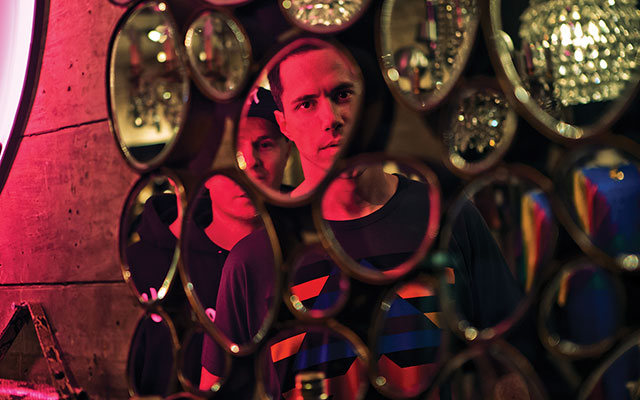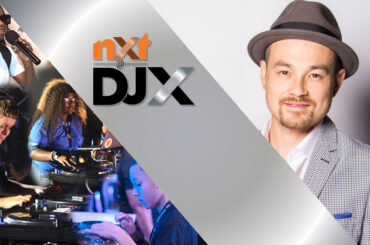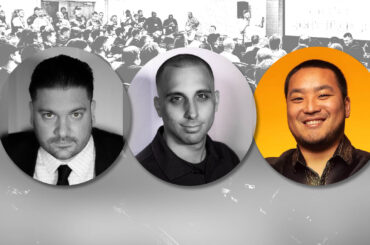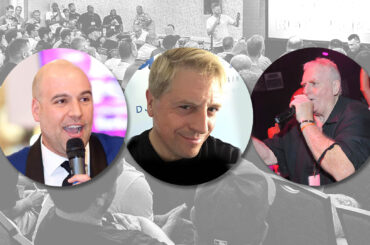Calyx & TeeBee have been making music together for over 10 years, but these days—unless it is behind the decks—the two drum-n-bass DJ/producers rarely see each other.
“We’re on the road a lot, and making music takes so much time—it’s more efficient to work on separate projects to maximize the time,” says TeeBee. “When you’re together, you tend to go for more of a safe option because you want to get results from the time. Separately, we try and impress each other.”
The duo’s third album on Ram Records, 1×1, has been its most difficult one to date. Living in different cities in the U.K.—the Norwegian TeeBee (aka Torgeir Byrknes) in Lewes and the Englishman Calyx (aka Tony Cons) in London—they have identical home studio set-ups, bar a few outboard synths. Tracks bounce back and forth between their studios many, many times before finishing the version eventually heard on the album.
Covering the genre’s spectrum of styles, 1×1 hits all the marks with darker, throttling tones as much as it does with feelgood, jump-up vibes. Calyx’s smooth, soulful vocals highlight on “Nothing Left” and “Cloud 9,” while the chants from featured MC Doctor on “Ghetto” and “Where We Go” add further dimension, as do the silky pipes of Ayah Marar on “The Fall.” Through its three albums, the duo has sharpened its songcraft, while the originality of their productions hasn’t waned.
“Virus TI Snow is one of the few things that has bridged multiple albums—it’s phenomenal,” says Calyx of the duo’s standby synth. Calyx’s other active synths are Prophet 12 and Moog Sub Phatty, while TeeBee favors Prophet 8 and Moog Voyager. The two continue to use Logic Pro X for their DAW, eschewing the Ableton Live tidal wave.
“It’s a conscious thing,” says Calyx of the group’s studio approach. “I was like that from the start. I went with an Akai sampler, just to not have an E-MU sampler like 95-percent of other drum-n-bass producers. Secretly, I was jealous of their samplers, as their filters were so much better. But if you can find a way to sound a bit different, then it’s got to be done in order to have a unique identity and separate yourself from the herd.”
The big change in making 1×1 was Calyx & TeeBee’s return to hardware and further integrating it with software. For Calyx’s vocals, he uses a Shure SM7B microphone into an SSL X-Rack VHD input module through an SSL-G Master Buss Compressor. Processing is done with FabFilter and iZotope plug-ins and through UAD plug-ins such as LA-2A and 1176, with Lexicon and EMT for reverbs, Neve 1073 for EQ, plus some hardware.
“We use a lot of bussing and automation of plugs before bouncing out stems of all the different sends and effects,” says Calyx. “The stems are then worked together and final processing goes through our hardware, usually some saturation through the Anamod ATS-1 Tape Simulator, and a touch of EQ and compression with A-Designs HM2EQ and HM2 Nail. The final vocal is imported into the track it’s destined for. Vocals are always worked on in separate projects or arrangements, as they get so intensive. The less clutter, the better.”
For DJing, the duo uses three later-model Pioneer CDJs and a matching mixer each—preferably Allen & Heath for sonics and control—routed into a third mixer they both can use. Between shouts, hand signals, intuition, unspoken understanding, and mind reading, the duo’s sets are more spontaneous than choreographed. In the DJ booth, as in the studio, they try to impress and surprise each other with teases, key matches, and drops.
“It seems like everyone only has one gear—they just keep ramming it as fast and hard as they can,” says TeeBee of other DJs they’ve heard on the road. “You get into a club at 9 p.m., and you have the local warm-up DJ playing Noisia & The Upbeats ‘Dead Limit’ as the first tune, while redlining the mixer. Where are they going to go from there? We have to play our hits, the tracks people expect and want to hear from us, and in an hour and 15 minutes, there is no room for experimenting. We love a two-hour set where we can play unexpected things—but the way we play it, it still becomes part of our identity.”







